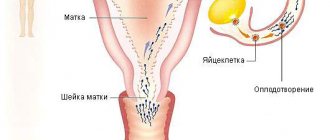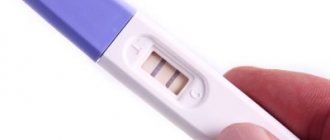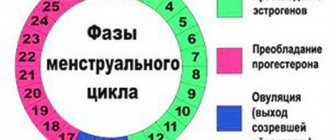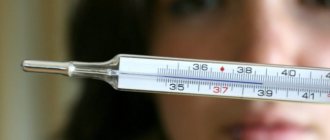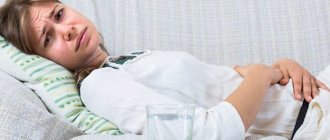What are the days when you can’t get pregnant? This is a pressing question for couples who prefer to have sex without contraception and still receive complete satisfaction from the process. Not everyone knows during what period you can’t get pregnant. The risk of becoming pregnant is reduced to a minimum, but not eliminated. Women ovulate monthly. This is the very period of the cycle when the body is completely ready to accept sperm for fertilization, that is, the most dangerous moment for sex without condoms, since during these days there is a high probability of getting pregnant. Although ovulation lasts 1-2 days, it is worth monitoring your cycle so as not to lose sight of the most favorable moment for conception. Basically, ovulation occurs in the middle of the cycle, and at this moment a woman can be much more active sexually. But this does not mean that at other times it is safe to have sex without protection and not get pregnant.
Are there days when you can’t get pregnant?
No one will give you guarantees during what period you will not become pregnant.
So, even if you keep a calendar of your cycles and regularly note all changes, you cannot be sure of excluding such possibilities. There are days in the female body when the risk is minimal.
The safest days of the menstrual cycle are considered to be 2 days before it starts and 2 days after it ends.
Therefore, to determine the onset of ovulation or the safest period, it is necessary to calculate the duration of the menstrual bleeding cycle itself. But here some difficulties arise. It is impossible to make the most accurate calculation without maintaining a frequency calendar. In addition, if you keep a menstruation calendar, but there is irregularity or shift in cycles, then you will not be able to perform a high-quality calculation of the days when it is impossible to get pregnant. As you know, shifts in menstruation or its instability are phenomena that are influenced by many factors. Such factors are stress, women's diseases, even taking medications.
When is pregnancy possible?
A woman's fertility, or her ability to conceive and carry a child, changes throughout her life. Thus, it is easier for young women to become pregnant, since in the absence of diseases, abnormalities in the development of the genital organs, and regular sexual activity, pregnancy occurs in 60% of cases within six months. Difficulties with conceiving in a young couple for two years already require identifying the causes and diseases of the woman or her partner.
But if a woman is taking contraception, or for other reasons attempts to conceive a child are postponed, then if there are difficulties with conceiving after 35 years, you should not hesitate. Absence of pregnancy within a year requires consultation with a doctor. This is due to the fact that as you age, ovulation may not occur in every menstrual cycle.
Fertility can also depend on hereditary factors; often women of the same gender have difficulty conceiving in the absence of visible pathologies. If a woman is planning a pregnancy, then she needs to know during what period she can become pregnant. When can you get pregnant is also of interest to those who want to avoid it.
Calendar calculation method
The calendar method for calculating the safe period is based on an analysis of the menstrual cycle of a certain period, for example, one year. Here it is necessary to take into account all factors, including the use of hormonal drugs, which may cause changes in the cycle. If, after looking at the cycle throughout the year, you find that it has shifted by a few days each time, you will not be sure of anything. The ovulation period is very short, so it is quite easy to be off by a day in its calculations.
So, to perform the calculation, you need to find out the duration of the shortest and longest period of the menstrual cycle. Subtract 18 from the cycle with the minimum duration of menstruation, then you get a day with a high risk of conception. You can subtract 11 days from the maximum duration of the menstrual period, determining the end day for conception in case of unwanted pregnancy. On average, this interval is about 12 days.
Ovulation occurs during childbearing years in all women. The duration of ovulation takes only 1-2 days, this is the period when a healthy egg is completely ready for fertilization. During this period, it is not advisable to have sex, at least without reliable contraception.
The least dangerous periods are the days before menstruation and immediately after the end of the process of self-cleansing of the female body.
How to calculate days of conception using the calendar method?
Using a calendar, it is possible to more or less reliably determine good and bad days for conception only if the menstrual cycle is regular. If the dates of menstruation change every time, then it will not be possible to accurately calculate the onset of ovulation. In this case, more reliable methods are used to protect against unwanted pregnancy or planning a baby. In addition, the use of hormonal contraceptives nullifies all calendar calculations.
You can identify the optimal days for conception by analyzing the menstrual cycle for six months, or better yet, for a year. To do this you need:
- Find in the calendar the longest and shortest cycles observed over the course of a year or six months.
- Subtract 18 from the number of days in a short cycle to get a number indicating the day from which fertilization is most likely.
- Subtract the number 11 from the day of a long menstrual cycle to determine the day that ends the best period for conception.
For example, the shortest cycle of the year covers 26 days, and the longest one – 30. 18 is subtracted from 26, and 11 is subtracted from 30, resulting in the numbers 8 and 19. Thus, in this option, the best time for pregnancy falls on the period from 8 to the 19th day of the month.
Probability of conception during the premenstrual period
During menstrual bleeding, the conditions for egg implantation become significantly more difficult, but this does not mean that pregnancy is impossible. Girls with irregular sexual relations or with different partners significantly increase the risk of becoming pregnant. The body may react with unscheduled ovulation. The reaction may occur if a couple interrupts sexual intercourse as a form of protection. Thus, substances found in sperm provoke ovulation in the female body.
In this case, we can conclude that only a stable cycle, regular sex life with a regular partner, and the absence of stress can have a positive effect on the calculations.
The release of blood clots during the menstrual cycle is unfavorable for conception, so many men and women consider this moment “safe”, but the possibility of pregnancy cannot be excluded. Pregnancy is possible if there are hormonal imbalances, illness or prolonged periods.
On which days you can’t get pregnant - a lot depends on the answer to this question. Therefore, we would not recommend placing too much trust in the methods for calculating these days, which we present below. But of course, it's up to you to decide.
Surely you know that you can’t conceive a child on any day, since you’ve already asked yourself the question of calculating “dangerous” days. Yes it is. During one menstrual cycle (which lasts on average 28 days), the chance of becoming pregnant is high for about 7 days in the middle of the cycle. And the remaining ones are the days when you cannot get pregnant. How to calculate “when it is possible and when it is not possible?”
The most popular method is to measure the temperature in the rectum. All you need is a regular mercury or electronic thermometer (the first will be more accurate and therefore preferable). Next, you need to measure your rectal temperature in the morning every day, at least for the first half of the cycle, and do not forget to write down all the measurement results.
On days when you cannot get pregnant, the temperature will be below 37 degrees. But this is not an axiom; there are exceptions. Until ovulation occurs, the rectal temperature is at the specified level. However, sperm are very tenacious, and even when in the female genital tract, they can maintain their viability for several days. Therefore, sexual intercourse that occurred 5 days before ovulation may also be “effective”. Next comes ovulation - it is expressed by a rise in temperature values to 37 degrees and above. The egg remains viable for no more than 2 days, which means that the days when you cannot get pregnant come just after ovulation. That’s why they say that the safest days are those just before your period. However, there is also a nuance here - an elevated temperature can be not only due to the maturation of the egg, but also due to illness, taking certain medications, after sexual intercourse, if in less than 6 hours the woman took a vertical position (for example, got up at night in toilet). Accordingly, ovulation did not occur on that recorded day, and the couple “relaxed” on the day when ovulation actually occurred. The result is pregnancy. It is quite difficult to use the basal temperature chart for women who have an irregular menstrual cycle.
Another way to determine ovulation and safe days, respectively, is through tests. Very reliable, but it turns out to be too unprofitable, since you will have to test for several days in a row, and this costs money. In general, for those who want to save on contraception using the calendar method of preventing unwanted pregnancy, this option is not at all suitable. Accordingly, ultrasound is an even more expensive method that also requires time.
Therefore, the only option left is to monitor your feelings. During the period of egg maturation, many expectant mothers experience a pulling in the lower abdomen; the pain may be stabbing or cramping, but not regular. There is abundant mucous discharge from the vagina. Accordingly, having learned on which days you cannot get pregnant, the calendar can create and display “dangerous” and “safe” days there in different colors. By the way, there are quite good convenient programs that allow you to create a calendar. If your cycle is regular, then it makes sense to use them.
Let's draw conclusions.
1. The safest days are the beginning of menstruation, as well as the days just before the start of the next menstruation.
2. You cannot get pregnant during an anovulatory cycle, when ovulation does not occur.
3. You can’t get pregnant in the first 2 weeks after giving birth (who would even think of having sex these days?)
This is how you can calculate which days you can’t get pregnant and which days you can. As we already wrote at the beginning of this article, none of the described methods is 100% correct. It is better to choose an effective contraceptive, there are more than enough varieties. Do you have rare sexual relations? Then oral contraceptives are unlikely to suit you. It would be wiser to use condoms or even spermicides - “chemical” contraception. With regular sexual relations and one healthy sexual partner, gynecologists recommend using an intrauterine device, a Ring vaginal ring, or birth control pills. By the way, birth control pills, although not combined (containing only 1 hormone), can also be taken by nursing mothers. In general, there is always a choice. Do not risk your health, it is better to go for a consultation with a gynecologist.
The main mission of a woman is to give birth to a child, raise and continue the family line. Sooner or later, the realization comes that a woman is ready to become a mother, but pregnancy does not always occur as soon as such a desire appears. In order to get pregnant as soon as possible, you need to prepare your health for this important stage in life, and also know on which days the probability of successful fertilization is highest.
After an important decision is made by a woman and her husband that a child should appear in the family, the first question that arises is: “When will we close it?” It happens that such a question also arises in the opposite situation, when pregnancy is unwanted and the couple is trying to avoid such an event. In fact, it is impossible to get an exact answer, since each woman and her body is individual. But you can still understand this topic if you delve into the features of a woman’s physiology.
A woman who monitors her menstrual cycle and other subtleties should always have a personal calendar available, thanks to which she can accurately determine favorable days for conceiving a fetus, as well as unfavorable days for those who do not yet want to get pregnant.
In fact, the calendar counting of menstruation and ovulation is quite popular among women, although it is not 100% accurate. Using such a calendar, you can regularly mark the days of menstruation, calculating the fertile and infertile phases.
The thing is that when a woman reaches childbearing age, she can only get pregnant on certain days when ovulation starts, approximately in the middle of the current cycle. All other days are an infertile phase that does not accompany the possibility of conceiving a fetus. But often on such days there are exceptions to the rules, so contraception by calculating ovulation is not always effective.
Typically, a woman's menstrual cycle lasts approximately 25 to 35 days, starting from the first day of her period. And as soon as menstruation has stopped, the follicular phase is activated. This phase is characterized by the synthesis of follicle-stimulating hormone by the endocrine glands, and the maturation of the egg begins. And approximately on days 9-14 of the cycle, the follicle ruptures, which among women is called ovulation.
Already on the second day after the start of menstruation, the uterus begins to prepare for possible conception; endometrial growth begins in it. In the event that conception does not occur for some reason, the follicle narrows, producing progesterone. The resulting endometrium also disintegrates, leading to the next menstruation.
High probability of getting pregnant between the 8th and 20th day of the cycle
Overlapping the life spans of the egg and sperm, it can be argued that favorable days for conceiving a child, i.e. the days when a girl could become pregnant - provided she has a regular menstrual cycle (clear 26-day or clear 28-day) is the midpoint of the cycle, plus or minus five to six days from this midpoint.
Based on this, we can say with confidence: if unprotected sexual intercourse occurs these days or a condom breaks while protected, then the probability of pregnancy in this situation is quite high. During this period, the girl could become pregnant and the question becomes relevant: ? Everyone must answer this for themselves.
When is the likelihood of getting pregnant through unprotected sex low?
On all other days. If sexual intercourse occurs closer to the beginning of menstruation, for example, two to three days before menstruation or towards its end - on the fourth, fifth, sixth and seventh day of the cycle, the lower the likelihood of pregnancy
. But not 100%. Why is that? Because sometimes it happens that sperm lives longer or ovulation shifts to a later or earlier date. Therefore, all calculations are quite conditional.
But a certain rule still exists. It indicates the likelihood of pregnancy. Under the condition of a regular menstrual cycle, safe (closer to the end of menstruation) and dangerous days of the cycle (closer to the middle of the cycle) are distinguished.
Can a girl get pregnant during her period?
It is almost impossible to get pregnant during menstrual bleeding.
The exception is cases when ovulation for some reason occurred too early. But this happens extremely rarely. However, doctors are categorically against sex during menstruation.
This can be explained very simply - the likelihood of developing inflammatory processes in the uterus and endometriosis increases. To avoid harming yourself, you should abstain from sex during menstruation.
Sperm in the vagina - not 100% pregnancy
One more thing. If sperm gets into the vagina, this does not mean that pregnancy will occur one hundred percent. After all, a girl may not ovulate in every cycle.
In addition, the girl may have some additional factors that contribute to the failure of pregnancy. There may also be permanent causes of infertility or infertility in a certain cycle (for example, the corpus luteum is not fully formed or the follicle is not mature).
Infertility is a pressing problem
Not all men are able to fertilize if pregnancy does not occur.
It cannot be guaranteed that if on one of the dangerous days, for example the 14th, sperm gets into the vagina, the girl will definitely become pregnant. But the chance is high.
Here we need to remember that there are many infertile couples in the world who can have regular sex for many months, and pregnancy occurs only by the end of the year.
All women who have sexual relations are interested in 2 questions - how not to get pregnant and on what days you can get pregnant. Some married couples diligently do “this” for the sake of conception, others - for the sake of love and all-round intimacy. You don’t need to be an expert - there are physiological laws according to which fertilization occurs strictly on the days of ovulation. The question of which days there is a high probability of getting pregnant requires detailed consideration.
Menstrual periods
To gain knowledge about which day of the cycle you can get pregnant, you should consider the options for conception before the critical days, during the course of the days and after their completion.
- Premenstrual period
.
At this time, processes of endometrial rejection are taking place, coming out with the blood flow of menstruation. Usually, the egg, which at this time could become potential for fertilization, is also rejected. According to doctors, there are no prerequisites for an egg to attach to the wall of the uterus, so the likelihood of conception is low. And even in the case of repeated ovulation at this stage of the cycle, the hormonal background does everything to prevent pregnancy from occurring. But there are always exceptions to the rules.
For those women who have an irregular sex life and do not use protection, repeated ovulation is quite possible, and the days of vital activity of the sperm can give it a chance to fertilize the egg even in 2-3 days. If sexual activity is regular, the cycle is stable, the chances of getting pregnant are reduced to zero. - Menstrual period
. Just as in the previous situation, during menstruation the chance of conceiving a fetus is negligible. Unexpected “surprises” can only happen when: * menstruation is long, sperm can wait for the onset of planned ovulation; * unstable menstrual cycle, if menstruation occurs on an unexpected day and all calculations are automatically updated. - After critical days
. After the end of menstruation, it is difficult to get pregnant, since the prerequisites for this are unfavorable, but there are still exceptions. Since the life of sperm lasts up to about 7 days, for those women whose menstruation ends quickly, there is a good chance that sperm will survive until ovulation begins. Especially if contact between partners occurs 3-6 days after the end of the critical days.
When can you get pregnant after taking birth control pills?
Doctors recommend stopping birth control 9 weeks before conception occurs. It is during this period of time that the female reproductive system will be restored to normal. Below are examples of when you can get pregnant after taking birth control pills:
- Regulon . It is necessary to plan conception after using such an oral contraceptive only after 3 months. It is during this period that the woman’s body will completely remove the accumulated hormonal components.
- Jess and Yarina . These drugs, as in the previous case, should be discontinued no earlier than 3 months. Pregnancy can occur either immediately or 12 months after stopping the pills. Its onset is influenced by the duration of use of contraceptives by Jess and Yarina. The longer a woman takes such drugs, the longer she will have to wait for pregnancy to appear.
- Novinet . After discontinuation of this drug, you may not need to take breaks before conception. This is due to the amount of hormones in the product, which is several times different from other tablets. The concentration of such substances in Novinet is much lower.
It should be remembered that refusing contraception cannot guarantee an easy and quick pregnancy. This is influenced by the duration of use of the products, past illnesses, health status and age of the woman.
On what days are you most likely to get pregnant?
It is possible to determine exactly on which days a woman’s probability of getting pregnant is highest, but we cannot talk about 100% information. A personal gynecologist can help with this, who, according to medical theory and professionalism, will be able to calculate the days of ovulation, and also, having studied the individual characteristics of the female body, give recommendations for conception.
There are several methods to determine on which days the probability of getting pregnant is highest:
- Basal temperature. By measuring basal temperature, you can determine the onset of ovulation. The thermometer will show a temperature of 37 to 37.3 degrees. Immediately after sleep, you need to measure your anal body temperature, which gives the most accurate readings.
- Ovulation test. You can purchase such a test at a pharmacy. The specifics of such a test are similar to the principle of conducting a test for possible pregnancy. Once the test is placed in the urine, one or two stripes will appear. In the second case, the woman can be sure that she has already ovulated. But such a test is carried out 2-3 days in a row at a specific time of day.
- Ultrasound. Doctors prescribe such studies for those women who cannot become pregnant due to a diagnosis of infertility. This diagnosis is carried out 10 days after the final day of menstruation. During the examination, the specialist looks at the growth of the follicle in the ovary, which is dominant. There are cases when pregnancy does not occur due to the fact that ovulation does not occur at all.
Ovulation tests.
Ovulation tests are much more modern and more accurate. They are similar to tests that determine pregnancy, and even the result is shown in two stripes. The difference between them is that the substance, the reagent contained in the test, is designed to react with another hormone - LH (luteinizing hormone). This hormone is formed 24-36 hours before ovulation. Therefore, it is important to do tests daily, and at a certain constant time, so as not to miss the long-awaited event. After this time, the LH content drops sharply, and the tests become “negative”. As a rule, manufacturers include several test strips in the kit, which makes this method very convenient and most justified.
Table: when is it easier to get pregnant
To determine which days of the cycle a woman can get pregnant, a cycle table comes to the rescue. First of all, you need to calculate the duration of a woman’s menstrual cycle. To do this, you need to know that its onset starts from the first day of menstruation and the cycle ends on the eve of the second menstruation after it. Next, you can calculate the days of ovulation, when the ideal period for conceiving a fetus occurs, using a special table.
Table: “on which days of the cycle you can get pregnant”
It is important to know!
If a woman has irregular menstruation, the shortest menstrual cycle in the previous 4 months should be taken as a basis.
Thanks to such a calendar, you can simply calculate the approximate days of the start of the ovulation period; it is then that you need to carry out various methods for determining the days accompanying conception. This could include testing for ovulation for several days, measuring basal temperature in the morning, and even going to see your doctor.
Calculation example
A clear example of calculation: A woman’s cycle lasts 28 days. This means that on the 11th day after the start of menstruation, you need to start testing for ovulation.
Reading time: 6 minutes
During each menstrual cycle, there are days when the likelihood of conception is very high, increased or unlikely. The most favorable period for conception is ovulation, 1-2 days in the middle of the cycle. The period before it is considered relatively safe, and after it a period of increased likelihood of conception.
Everything seems simple, but there are many nuances that complicate the calculation. Otherwise, there would be no unwanted pregnancies, and women who have been unable to conceive a child for years would have given birth long ago. Let's look at the question of what days you can get pregnant in more detail.
Is it easy to get pregnant on the day of ovulation?
There are exact calculations for when you are most likely to become pregnant.
But girls still ask on what day of ovulation you can get pregnant. 100% cyclic calculation methods have been developed, but where do the errors come from? The classic menstrual cycle is 28 days (like the phase of the moon), which is why it is called “menstruation”. It is necessary to count from the first day of bleeding. There is no doubt whether it is possible to get pregnant on the 12th day of the cycle; it is at this time or a little later that the “X” moment occurs.
Attention: The egg is ready just in the middle of the cycle, approximately 12-14 days. But sometimes it comes out earlier or later, hence the errors in calculations!
Some women have a slightly longer cycle - 30-31 days, the calculations are the same, you can get pregnant on days 13-16.
Gynecologists noted a menstrual period of 35-36 days, when ovulation occurs on days 17-19, but this is an exception. Girls often wonder what is the probability of getting pregnant the day before ovulation? Yes, sperm “knows how to wait,” or rather, its vitality in the female body is great. If the seed does not penetrate further than the vagina, it will die after 2-3 hours. Sperm that penetrate the fallopian tubes can live up to 5-6 days. There they “wait” for a mature egg, which is released every month.
If fertilization does not occur for various reasons, the seed and mother cell die. The menstrual cycle ends, the uterus “cries tears of blood about a failed pregnancy,” as they explain to medical students. This makes it clear why you can get pregnant on a day other than the day of ovulation if you had intercourse a little earlier. But it will still happen when the egg is ready - at ovulation. This will not happen if the sluggish “live ones” or the egg “travels” for a long time in the fallopian tubes.
How to correctly calculate which days you can’t get pregnant (with a regular cycle)
In order to accurately calculate the days that are relatively safe for sex, you need to keep a calendar of critical days for six months or longer in order to calculate the duration of the menstrual cycle. If your cycle is irregular, this method of contraception will not suit you. For small deviations, you can make the following simple calculation:
We take into account the duration of the shortest and longest monthly cycle.
We subtract the number 18 from the shortest cycle. For example, 23-18 = 5, so already from the fifth day of the cycle the probability of getting pregnant will be high.
We subtract the number 11 from the longest cycle. For example, 30-11 = 19, so already from the nineteenth day the chance of getting pregnant sharply decreases.
According to the results, from the 5th to the 19th day of the cycle there is a high probability of conception; on the remaining days it decreases significantly.
Based on physiology
The physiology of any woman of childbearing age is structured in such a way that the chance of becoming pregnant exists every month. This is called the ovulation period. At this time, the egg is ready for fertilization, and this period lasts 1-2 days. It coincides with the middle of the menstrual cycle. For example, if a woman has 28 days, then ovulation occurs on days 14-16. With a 35-day cycle, this is approximately day 17. Many women want to know exactly when the days of ovulation occur, because if the cycle is not stable (one month has 28 days, another - 31), then you can make a mistake in calculating them.
In this case, you can use other methods:
- Buy an ovulation test at the pharmacy, carefully read the instructions, and if the test result is positive, you should (or should not) have sex. Thus, the egg, ready for fertilization, merges with the sperm and an embryo is formed.
- Measuring basal temperature. You need to start measuring the temperature with a thermometer in the mouth or rectum from the first day of the cycle, that is, with the onset of menstruation. Enter data into a chart every day. During the onset of ovulation, you will experience a slight increase in temperature. If at the beginning of the cycle it was 36.8, then during the ovulation period the thermometer will show 37–37.2. This is a signal about the onset of ovulation and a favorable period for conception.
- Changes in well-being. During the period of ovulation, the breasts swell a little, the stomach hurts, and vaginal discharge becomes stringy.
- Ultrasound. This method most accurately diagnoses the period of ovulation.
More on the topic
Ovulation period
How long does an egg live after ovulation?
Is it possible to get pregnant immediately after menstruation?
When does pregnancy occur after conception and ovulation?
Is it possible to get pregnant after menstruation?
Based on these methods, women can predict “dangerous” and “safe” days of their cycle.
How to get pregnant with an irregular cycle
Planning a pregnancy with an irregular cycle is quite difficult, because in addition to the need to control the onset of ovulation, you also need to monitor your health. At the stage of pregnancy planning, every woman should lead a healthy lifestyle, eat right and maintain hormonal balance. The Time Factor complex helps to establish the production and natural ratio of progesterone and estrogen in the body. Biologically active substances in the complex will help not only alleviate the symptoms of premenstrual syndrome, but also normalize the cycle, and, accordingly, make it possible to identify days suitable for conception.
Cycle phases
To make it easier to understand on what day you can get pregnant, it is advisable to study the basics of monthly cycles:
- From the first day of menstruation to the day of ovulation, this is the first phase, which is called the follicular phase. During this period, the follicles mature to release the eggs. There can be one or many follicles. The quality of ripening depends on the level of luteinizing hormone.
- Then ovulation itself occurs. In this case, the first phase ends. This moment is considered the most favorable for conception.
- Immediately the next day after ovulation, the second phase begins, during which the corpus luteum is formed. This phase will proceed normally if the level of the hormone progesterone is sufficient, regardless of whether pregnancy has occurred or not.
- If pregnancy does not occur, your period comes 14-16 days after ovulation. It is worth noting that the second phase in a woman can be shorter or longer.
It happens that a woman’s menstrual cycle is very short - only 21-23 days, and the second phase is slightly longer than usual. Therefore, sometimes the question arises about what day of your period you can get pregnant and whether this is possible.
Is it possible to get pregnant before your period?
Before menstruation, uterine tissue is shed, which then comes out with the blood flow. Along with the tissues, the egg, which could potentially be fertilized at that time, is also rejected. There are no conditions for the egg to attach to the wall of the uterus. The hormonal background that develops in the female body at this time makes conception difficult even with repeated ovulation.
At the same time, a woman who has an irregular sex life and is also protected by the method of interrupted sexual intercourse may well experience repeated ovulation, and during those 2-3 days while the sperm remain viable, the egg may mature and, having broken through the follicle, meet sperm.
If a woman has sex with a regular partner, it is almost guaranteed that she will not become pregnant before her period.
How can you determine pregnancy?
Some of the most common symptoms that conception has occurred are:
- Pain in the place where the ovary is located. In addition, a woman may feel slight discomfort in the lower abdomen.
- Severe sensitivity to smells and nausea. Typically, this condition appears in the 3rd week of pregnancy and accompanies the expectant mother for several more months.
- A constant feeling of weakness and fatigue. This is due to a woman’s decreased immunity due to pregnancy. Sometimes a slight runny nose appears, which soon goes away without consequences.
- Copious, transparent discharge begins to appear from the vagina. In addition, they have no smell. After a few days they disappear and begin after a short period of time.
- Suddenly, libido increases greatly.
- Sleep is disturbed and insomnia appears. This is due to hormonal changes in the woman’s body.
- Painful sensations in the lower back or back. This condition occurs from time to time throughout the entire period of pregnancy.
- Swelling of the mammary glands. In this case, even a slight touch to the breast can cause discomfort in the woman. As a rule, this condition appears 2 weeks after conception.
- Lumps around the nipple. In medicine they are called Montgomer's tubercles. These small growths are found on the areolas near the nipples.
The question of when you can get pregnant, on what days, worries many women who want to become mothers. To find out, you can use different methods (counting days or using a test). They all have their own characteristics and give almost one hundred percent results.
Is it possible to get pregnant immediately after menstruation?
Immediately after menstruation, conditions arise that are not entirely suitable for conception. However, fertilization of the egg can still occur for several reasons.
The lifespan of sperm can be 5-7 days under favorable conditions. If the menstrual cycle is short, then sperm may well wait for ovulation, especially if sexual intercourse occurred 3-5 days after the end of menstruation.
In some cases, during one menstrual cycle, several eggs mature at once with a slight spread, so the chances of conception are significantly increased.
Even in women with a stable menstrual cycle, the timing of ovulation shifts from time to time, so the accuracy of calculations using the calendar method can be low.
When can you get pregnant after hysteroscopy of an endometrial polyp?
Many women are interested in when can you get pregnant after hysteroscopy of an endometrial polyp? Experts say that at least 8 weeks should pass after such surgery. This precaution will help prevent infection. In addition, doctors can prescribe medications to a woman to normalize hormonal levels in her body.
It is possible to return to full sexual activity no earlier than 3-4 weeks if the operation is successfully completed . If there are indications, this period may be extended. The woman also needs to undergo ultrasound diagnostics for a complete examination of the organs. This will help prepare you for pregnancy.
When can you get pregnant, on what days can this be done after removal of the endometrial polyp? Experts say that the most optimal period for conception after hysteroscopy of such a growth is considered to be a time period of 6 months. It is by this moment that the woman’s health will return to normal and be fully restored.
How to calculate when you are most likely to get pregnant
There are several more or less accurate ways to calculate days favorable for conception:
Basal temperature measurement method
allows you to determine the onset of ovulation with an accuracy of up to a day - at this time the basal temperature is 37-37.3 degrees. The most accurate readings are obtained from measurements in the anus. They should be carried out daily immediately after waking up.
In cases such as poor sleep (less than 6 hours), consumption of alcohol or medications the night before, or sex, the accuracy of measurements may be impaired. To obtain more reliable results, it is recommended to keep a calendar of basal temperatures. Before ovulation, the basal temperature is 36.6-36.9 degrees, and its increase by 0.2-0.4 degrees means the onset of ovulation.
Ovulation tests
modern method of pregnancy planning/contraception. Ovulation tests are very similar in principle to pregnancy tests. The result, which is two stripes, appears 10 minutes after placing the test in a container with urine. The difference is that the ovulation test must be done several days in a row.
The test is based on the interaction of the reagent with luteinizing hormone, which begins to be produced by the female body 20-30 hours before ovulation. To ensure the result is as accurate as possible, tests are carried out over several days in a row at a certain time.
Folliculometry
(ultrasound examination) allows you to determine with great accuracy on which days you can get pregnant. Doctors advise women who are suspected of infertility to undergo this study. An ultrasound scan must be performed ten days after the last day on which menstrual bleeding was observed.
Starting from the first visit to the ultrasound room, on the 10th day after menstruation, the doctor evaluates the growth of the dominant follicle in the ovary. As soon as the follicle reaches a size of 20-24 mm, it ruptures and the egg begins its journey to the uterus. Sometimes ovulation does not occur; in other cases, using the endometrium, it is possible to trace the moment of implantation of the egg into the wall of the uterus.
Subjective sensations
may also indicate days that are favorable for conception. These signs include:
- Increased sexual appetite;
- Pain in the lower abdomen or near the ovaries;
- The appearance of copious transparent discharge. This discharge is unlike discharge during gynecological diseases; it is colorless, odorless, and disappears after two to three days.
Are there safe days?
The process of conception is inextricably linked in a woman with the process of ovulation. Ovulation is a period of the menstrual cycle when an egg is released from the follicle, which is found in large numbers in the female ovaries, and begins its movement through the fallopian tubes towards the uterus.
After leaving the follicle, the egg retains its fertile properties for 12–24 hours.
Did you know? In almost all species of mammals except humans, ovulation is accompanied by clearly visible physiological changes in the behavior and appearance of the female, which allows males to understand when it is time to begin courtship in order to have offspring.
Despite the fact that the ovulation process can often be calculated with fairly high accuracy, sometimes under the influence of various environmental factors (stress, hormonal imbalances, infectious diseases, etc.) ovulation may be delayed, occur too early or be absent altogether.
The latest phenomenon in medicine is called the anovulatory cycle.
Special ovulation tests, as well as calculation methods, are designed to help a woman calculate on what day after her period she can become pregnant.
The most popular of them is called the calendar method and is based on the statement that a healthy woman with a regular cycle ovulates on the 15th–16th day.
It is worth considering that there cannot be a 100% guarantee of the fact that you have or do not have a chance of getting pregnant on a given day based solely on calculation methods.
Therefore, it is always recommended to additionally check the fact that you are ovulating through special tests that determine the presence of luteinizing hormone in your urine, which is released in a very large volume during the ovulatory period.
It will be useful for you to know that reproductive function is influenced by anti-Mullerian hormone, follicle-stimulating hormone, prolactin hormone, and fertility level.

